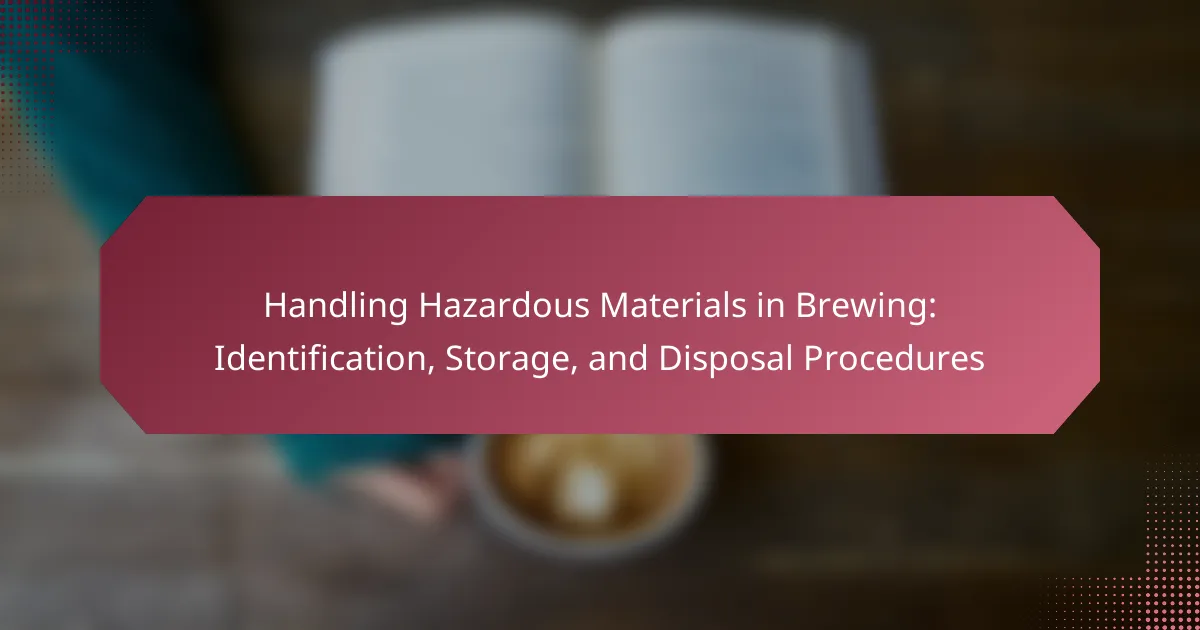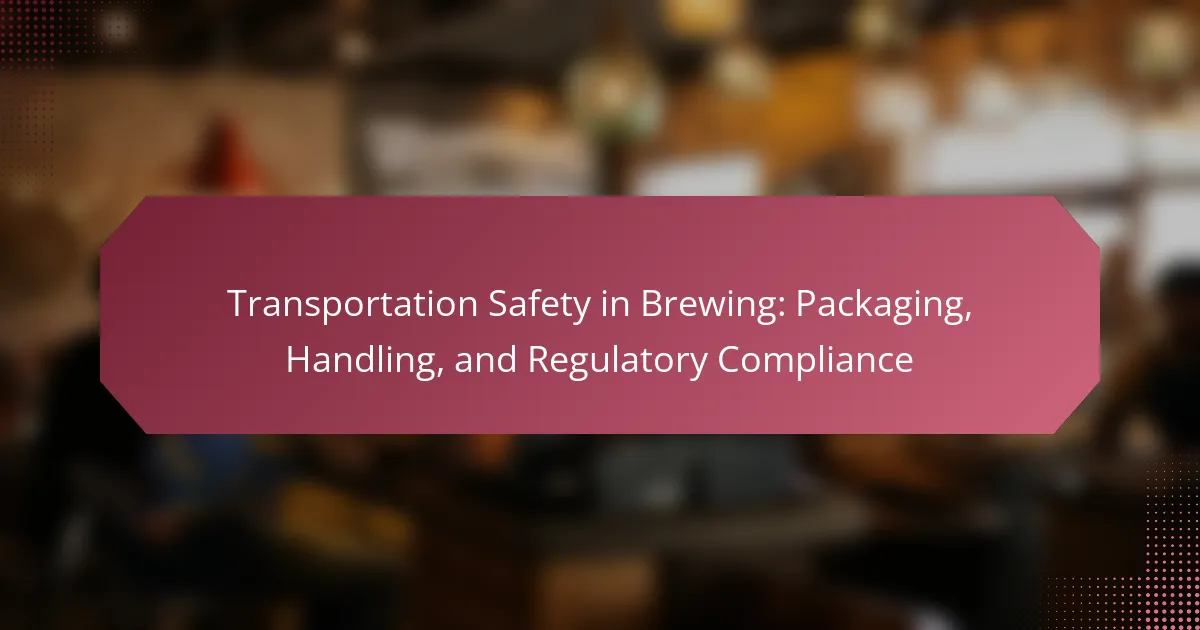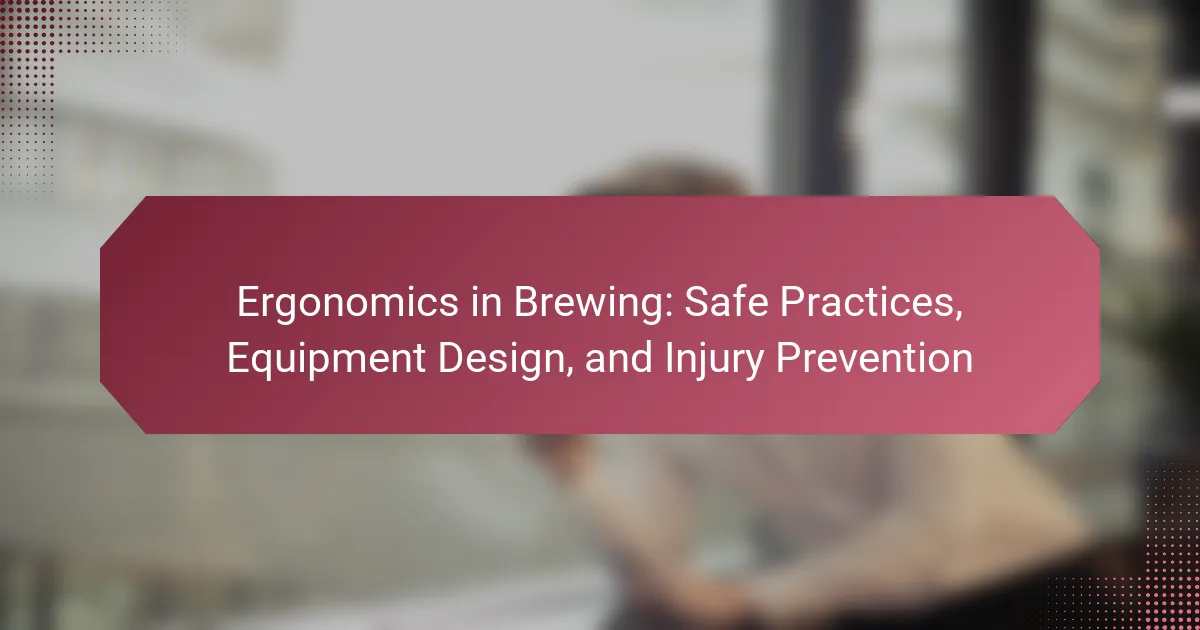Hazardous materials in brewing are substances that can pose risks to health, safety, or the environment, including chemicals used in cleaning, sanitizing, and processing. This article outlines the identification, storage, and disposal procedures for these materials, emphasizing the importance of proper labeling, secure storage, and adherence to regulatory guidelines such as OSHA standards. Key practices for managing hazardous materials include temperature control, spill containment measures, and regular inspections to ensure compliance. Additionally, the article details the steps for disposing of hazardous materials, including proper segregation, documentation, and staff training to minimize environmental impact and meet legal requirements.
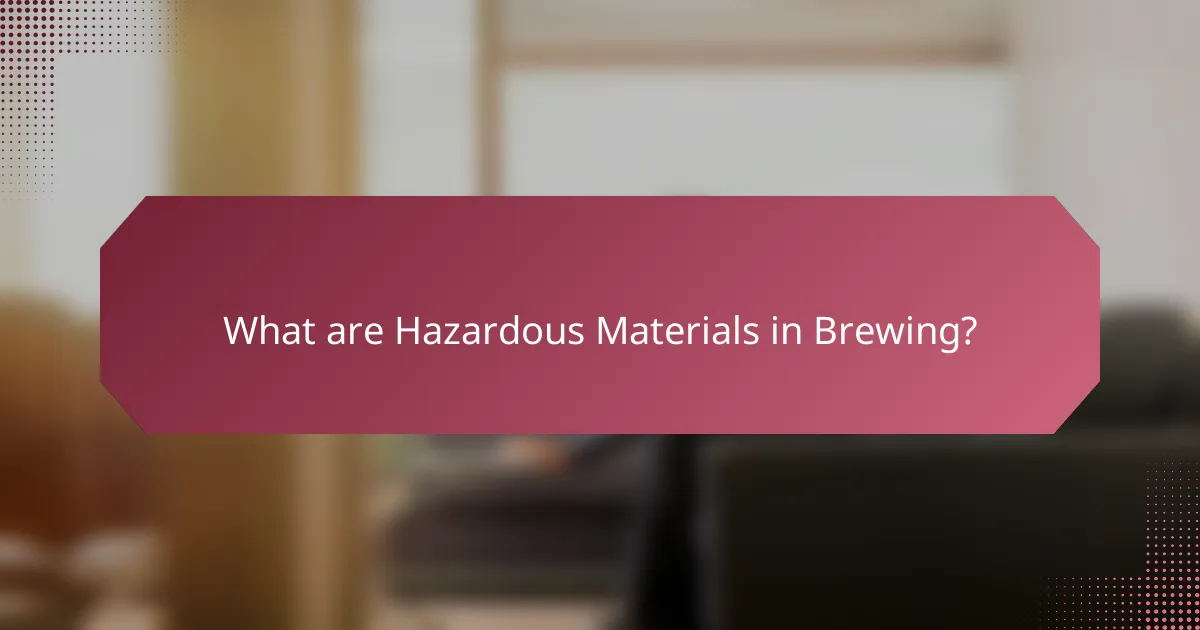
What are Hazardous Materials in Brewing?
Hazardous materials in brewing are substances that can pose risks to health, safety, or the environment. These materials include chemicals used in cleaning, sanitizing, and processing. Common examples are caustic cleaners, acids, and certain brewing additives.
Brewing processes may also involve hazardous materials such as carbon dioxide and ammonia. These substances require careful handling and storage to prevent accidents. Proper labeling and safety data sheets are essential for awareness and compliance.
Regulatory guidelines, such as OSHA standards, provide frameworks for managing these hazardous materials. Failure to adhere to these regulations can lead to serious health risks and legal consequences.
How can hazardous materials be identified in the brewing process?
Hazardous materials in the brewing process can be identified through Material Safety Data Sheets (MSDS). MSDS provide detailed information about chemical substances, including hazards, handling instructions, and emergency measures. Regular audits of the brewing facility can help identify potential hazardous materials. Training staff to recognize signs of chemical hazards is crucial. Monitoring equipment for leaks or spills can also indicate the presence of hazardous substances. Compliance with local regulations ensures hazardous materials are properly labeled and handled. Utilizing safety equipment, such as personal protective equipment (PPE), further aids in identifying and mitigating risks associated with hazardous materials.
What are the common types of hazardous materials found in brewing?
Common types of hazardous materials found in brewing include cleaning chemicals, solvents, and yeast byproducts. Cleaning chemicals like caustic soda and phosphoric acid are used for sanitation. Solvents may include isopropyl alcohol for equipment cleaning. Yeast byproducts can produce hazardous gases during fermentation. Additionally, some brewing processes generate waste that may contain heavy metals. Proper handling and disposal of these materials are essential to ensure safety in brewing environments.
How do you recognize hazardous materials by their labels?
Hazardous materials can be recognized by their labels through specific symbols and color codes. Labels often include pictograms that indicate the type of hazard, such as flammability or toxicity. The Globally Harmonized System (GHS) provides standardized symbols for easy identification. Additionally, labels contain signal words like “Danger” or “Warning” to convey severity. Precautionary statements outline safety measures and first aid instructions. The chemical name and manufacturer details are also present for reference. Understanding these elements is crucial for safe handling. According to OSHA regulations, proper labeling is mandatory for hazardous substances.
Why is it important to handle hazardous materials safely in brewing?
It is important to handle hazardous materials safely in brewing to prevent accidents and ensure worker safety. Brewing involves chemicals that can be toxic or flammable. Mishandling these materials can lead to spills, fires, or exposure to harmful substances. For instance, improper storage of cleaning agents can result in chemical reactions. These reactions may cause injuries or damage equipment. According to the Occupational Safety and Health Administration (OSHA), proper handling reduces risks of workplace accidents. Safe practices also comply with legal regulations. Compliance ensures the brewery operates within safety standards. Thus, handling hazardous materials safely protects both employees and the brewing process.
What are the potential risks associated with hazardous materials in brewing?
The potential risks associated with hazardous materials in brewing include chemical exposure, contamination, and environmental harm. Chemical exposure can occur through inhalation or skin contact with substances like cleaning agents and sanitizers. Contamination of the brew can happen if hazardous materials inadvertently mix with ingredients. This can lead to unsafe consumption and health risks for consumers. Environmental harm may arise from improper disposal of hazardous waste, affecting soil and water quality. Regulatory guidelines exist to mitigate these risks and ensure safe handling practices in the brewing industry.
How can improper handling of hazardous materials affect health and safety?
Improper handling of hazardous materials can lead to significant health and safety risks. Exposure to toxic substances can cause acute and chronic health issues. For example, inhalation of harmful vapors may result in respiratory problems. Skin contact with corrosive materials can lead to burns or allergic reactions. Additionally, improper storage can lead to chemical spills. These spills may create hazardous environments, increasing the risk of accidents. According to the Occupational Safety and Health Administration (OSHA), more than 5,000 workplace fatalities occur annually due to hazardous material incidents. Effective training and proper procedures are essential to mitigate these risks.

What are the Best Practices for Storing Hazardous Materials in Brewing?
The best practices for storing hazardous materials in brewing include proper labeling, secure storage, and temperature control. Hazardous materials must be clearly labeled to ensure safe handling. Storage areas should be locked and accessible only to trained personnel. Materials should be stored in designated areas away from food and drink. Temperature-sensitive substances require specific climate controls to maintain efficacy. Spill containment measures must be in place to address potential leaks. Regular inspections ensure compliance with safety regulations. Following these practices minimizes risks associated with hazardous materials in brewing.
How should hazardous materials be stored to ensure safety?
Hazardous materials should be stored in designated, secure areas. These areas must be well-ventilated to prevent the accumulation of harmful vapors. Storage containers should be clearly labeled with appropriate hazard symbols. Compatibility of materials is crucial; incompatible substances must be stored separately. Use secondary containment to prevent leaks and spills from spreading. Regular inspections of storage areas should be conducted to identify any potential hazards. Safety Data Sheets (SDS) must be accessible for all stored materials. Following these guidelines minimizes the risk of accidents and ensures compliance with safety regulations.
What are the recommended storage conditions for different types of hazardous materials?
Hazardous materials should be stored according to their specific classifications. Flammable materials require storage in cool, well-ventilated areas away from ignition sources. Corrosive substances need to be kept in non-reactive containers and away from moisture. Toxic materials must be stored in secure, labeled containers to prevent accidental exposure. Reactive chemicals should be isolated from incompatible substances to avoid dangerous reactions. All hazardous materials should be stored at appropriate temperatures as specified by safety data sheets. Proper labeling and signage are essential for safety and compliance. Regular inspections of storage areas help ensure safety and proper conditions are maintained.
How can you prevent cross-contamination during storage?
To prevent cross-contamination during storage, separate hazardous materials from non-hazardous items. Use designated containers for each type of material. Label all containers clearly to indicate their contents. Store incompatible substances away from each other to avoid reactions. Maintain proper storage temperatures to ensure material stability. Regularly inspect storage areas for leaks or spills. Implement a first-in, first-out system to manage stock rotation. Train staff on safe storage practices to enhance compliance.
What labeling and signage are necessary for hazardous materials storage?
Hazardous materials storage requires specific labeling and signage to ensure safety. Labels must include the identity of the hazardous material, hazard warnings, and handling instructions. Signage should indicate the presence of hazardous materials and provide emergency contact information. The Occupational Safety and Health Administration (OSHA) mandates these requirements under the Hazard Communication Standard. Compliance with these regulations helps prevent accidents and ensures proper handling. Proper labeling and signage improve awareness and communication among workers.
How does proper labeling contribute to safety in brewing environments?
Proper labeling significantly enhances safety in brewing environments by ensuring clear identification of hazardous materials. Clear labels help prevent accidental exposure to harmful substances. They provide essential information such as chemical names, hazards, and handling instructions. This information reduces the risk of mishandling and potential accidents. According to the Occupational Safety and Health Administration (OSHA), proper labeling is a key component of workplace safety standards. Compliance with these standards can lead to fewer workplace injuries and health issues. In addition, effective labeling supports emergency response efforts during spills or accidents. Overall, proper labeling is crucial for maintaining a safe brewing environment.
What types of signage should be displayed in storage areas?
Storage areas should display safety signage, hazard warnings, and identification labels. Safety signage includes general information about emergency procedures. Hazard warnings indicate the presence of hazardous materials. Identification labels specify the contents of storage containers. These signs help ensure compliance with safety regulations. They also promote awareness among employees. Proper signage reduces the risk of accidents. According to OSHA standards, clear signage is essential in hazardous material storage.
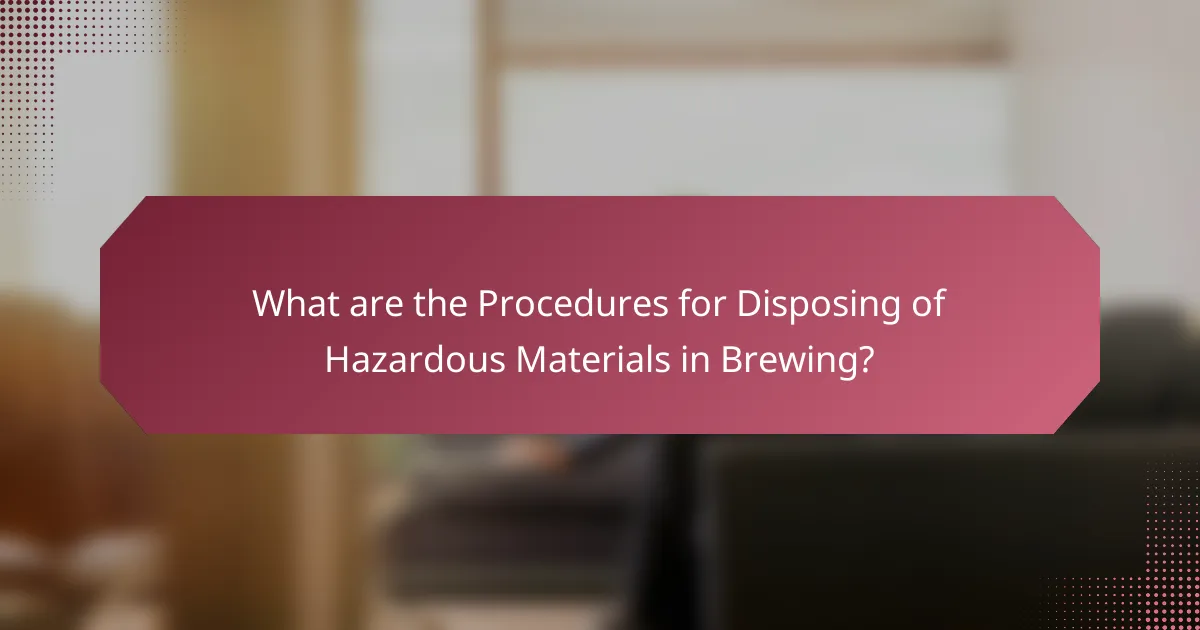
What are the Procedures for Disposing of Hazardous Materials in Brewing?
The procedures for disposing of hazardous materials in brewing include several critical steps. First, identify the hazardous materials present in the brewing process, such as spent grains, cleaning agents, or chemicals. Next, segregate these materials from non-hazardous waste to prevent contamination.
Then, follow local regulations for hazardous waste disposal. This may involve contacting licensed hazardous waste disposal companies. Ensure that all hazardous materials are labeled correctly before disposal.
Additionally, maintain proper documentation of the disposal process for compliance and auditing purposes. Training staff on these procedures is essential to ensure safe handling and disposal. Following these steps minimizes environmental impact and complies with legal requirements.
How can hazardous waste be properly disposed of in brewing?
Hazardous waste in brewing can be properly disposed of by following regulatory guidelines. Breweries must identify hazardous materials, such as spent chemicals and contaminated equipment. They should store these materials in labeled, leak-proof containers. Disposal should be conducted through licensed hazardous waste disposal companies. These companies ensure compliance with local, state, and federal regulations. Regular training for staff on hazardous waste protocols is essential. Documentation of waste disposal activities must be maintained for regulatory audits. Following these steps minimizes environmental impact and ensures safety in brewing operations.
What are the legal requirements for hazardous waste disposal in the brewing industry?
The legal requirements for hazardous waste disposal in the brewing industry include compliance with the Resource Conservation and Recovery Act (RCRA). This federal law mandates that hazardous waste must be identified, classified, and managed according to specific guidelines. Breweries must conduct waste characterization to determine if their waste qualifies as hazardous. If classified as hazardous, waste must be stored in labeled containers that meet EPA standards. Disposal must occur at licensed hazardous waste treatment, storage, or disposal facilities. Additionally, breweries are required to maintain records of waste disposal and adhere to state regulations, which may impose stricter requirements. Non-compliance can result in significant fines and legal repercussions.
How can brewers ensure compliance with local and federal regulations?
Brewers can ensure compliance with local and federal regulations by implementing comprehensive safety and training programs. These programs should focus on the proper handling of hazardous materials. Brewers must regularly consult the Occupational Safety and Health Administration (OSHA) guidelines. They should also be familiar with the Environmental Protection Agency (EPA) regulations regarding waste disposal. Keeping updated records of hazardous materials is essential for compliance. Regular audits can help identify any compliance gaps. Additionally, brewers should engage with local regulatory agencies for guidance. Training staff on safety protocols is crucial to maintaining compliance.
What are the best practices for minimizing hazardous waste in brewing?
Implementing best practices for minimizing hazardous waste in brewing involves several key strategies. First, breweries should conduct regular audits of their waste streams. This identifies sources of hazardous waste and areas for improvement. Second, using efficient production techniques reduces material waste. For example, optimizing ingredient usage can lower excess byproducts. Third, breweries can implement closed-loop systems. These systems recycle water and other materials, minimizing waste generation. Fourth, staff training is essential. Educating employees on waste reduction practices promotes a culture of sustainability. Fifth, breweries should collaborate with suppliers. Sourcing materials that generate less waste can significantly impact overall waste management. Lastly, adhering to regulations and guidelines ensures compliance and promotes best practices. Research indicates that breweries adopting these methods can reduce hazardous waste by up to 30%.
How can brewers implement waste reduction strategies?
Brewers can implement waste reduction strategies by optimizing their production processes. They can reduce water usage by recycling wastewater in cleaning and cooling operations. Implementing energy-efficient equipment can lower energy consumption during brewing. Brewers should also consider using by-products in other industries, such as selling spent grains for animal feed. Additionally, conducting regular audits can identify waste sources and areas for improvement. According to the Brewers Association, implementing these strategies can lead to significant cost savings and environmental benefits.
What role does recycling play in hazardous materials management?
Recycling plays a critical role in hazardous materials management by reducing waste and conserving resources. It helps to minimize the environmental impact of hazardous materials generated in brewing. By recycling materials such as solvents and packaging, breweries can decrease the volume of hazardous waste sent to landfills. This process also aids in recovering valuable materials that can be reused in production. According to the Environmental Protection Agency, recycling can significantly lower the emission of greenhouse gases. Effective recycling programs can enhance compliance with regulatory requirements for hazardous waste management. Overall, recycling is essential for sustainable practices in the brewing industry.
What practical tips should brewers follow when handling hazardous materials?
Brewers should prioritize safety when handling hazardous materials. Use personal protective equipment (PPE) such as gloves, goggles, and masks. Ensure proper ventilation in work areas to reduce inhalation risks. Label all hazardous materials clearly to avoid confusion. Store chemicals in designated, secure areas away from food and drink. Follow Material Safety Data Sheets (MSDS) for specific handling instructions. Regularly train staff on safety protocols and emergency procedures. Dispose of hazardous waste according to local regulations to prevent environmental contamination. These practices are essential for maintaining a safe brewing environment.
Handling hazardous materials in brewing involves identifying, storing, and properly disposing of substances that pose health, safety, or environmental risks. This article outlines the types of hazardous materials commonly found in brewing, such as cleaning chemicals and byproducts, and emphasizes the importance of compliance with regulatory guidelines. It details best practices for safe storage, including proper labeling and secure containment, as well as procedures for the safe disposal of hazardous waste. Additionally, the article highlights the significance of staff training and regular audits to maintain safety standards in brewing environments.
